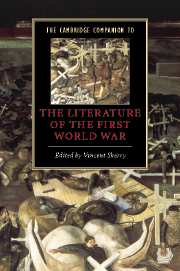Book contents
- Frontmatter
- Introduction
- Part I The Great War in British literary culture
- Part II The world war: Pan-European views, transatlantic prospects
- 6 The Great War and the European avant-garde
- 7 French writing of the Great War
- 8 The Great War and modern German memory
- 9 American writing of the Great War
- Part III Postwar engagements
- Guide to Further Reading
- Index
- Series List
9 - American writing of the Great War
from Part II - The world war: Pan-European views, transatlantic prospects
Published online by Cambridge University Press: 28 May 2006
- Frontmatter
- Introduction
- Part I The Great War in British literary culture
- Part II The world war: Pan-European views, transatlantic prospects
- 6 The Great War and the European avant-garde
- 7 French writing of the Great War
- 8 The Great War and modern German memory
- 9 American writing of the Great War
- Part III Postwar engagements
- Guide to Further Reading
- Index
- Series List
Summary
America's distinctive relation to the Great War originated in its remoteness from the event itself. Both because thousands of miles of ocean lay between the US and the battle in Europe, and because American troops did not participate in major action until the last year of hostilities, the First World War remained a virtual phenomenon to many US residents. The reports of German-Austrian aggression and Belgian-French imperilment did not lack for urgency (there were even German purposes to thwart closer to home, in Mexico and the Caribbean), but they did lack for immediacy. The American side of the Great War necessarily relied on institutions of representation - journalism, print propaganda, fiction, sermons - to make the war real in the place where it was not occurring. In important respects, American writing of the war was the war.
In the years before President Wilson abandoned the nation’s policy of neutrality and gained a declaration of war from Congress in April of 1917, the American public speculated about European statecraft, debated developments that might draw the US into the hostilities, and imagined the horrific new technologies of modern warfare like poison gas, massive artillery shelling, trench combat, and airplanes used as weapons.
- Type
- Chapter
- Information
- The Cambridge Companion to the Literature of the First World War , pp. 217 - 242Publisher: Cambridge University PressPrint publication year: 2005
- 3
- Cited by



